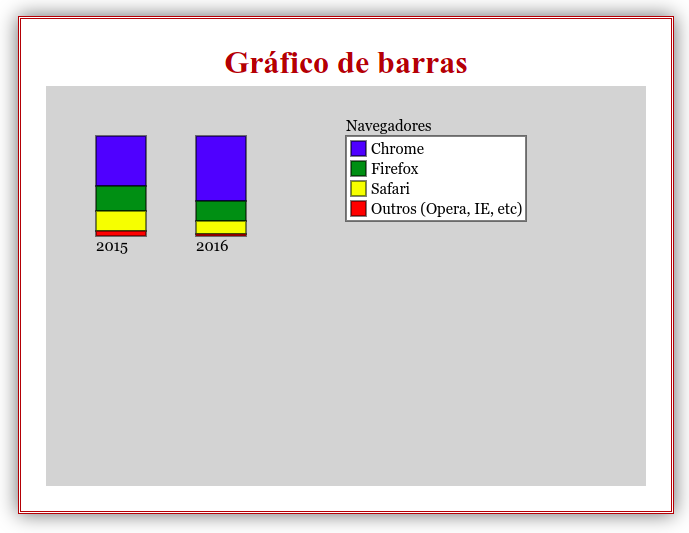Boa noite! Segue minha solução própria para construção do gráfico conforme proposto no exercício.
<!DOCTYPE html>
<html lang="pt_BR">
<head>
<meta charset="UTF-8">
<meta http-equiv="X-UA-Compatible" content="IE=edge">
<meta name="viewport" content="width=device-width, initial-scale=1.0">
<style>
* {
margin: 0;
padding: 0;
box-sizing: border-box;
}
body {
display: flex;
flex-direction: column;
align-items: center;
justify-content: center;
height: 100vh;
}
div {
display: flex;
flex-direction: column;
align-items: center;
justify-content: center;
border: 3px double brown;
padding: 25px;
box-shadow: 0 0 20px rgba(0, 0, 0, 0.6);
}
div h1 {
margin-bottom: 5px;
color: brown;
}
canvas {
scale: (0.1);
animation: .8s ease-in-out 0s 1 normal both running aparecimento
}
@keyframes aparecimento {
from {
transform: scale(0.1);
}
to {
transform: scale(1.0);
}
}
</style>
<title>Gráficos</title>
</head>
<body>
<div>
<h1>Gráfico de barras</h1>
<canvas width="600" height="400"></canvas>
</div>
<script>
function getContext() {
return document.querySelector("canvas").getContext("2d");
}
function drawRectangle(x, y, width, height, color, stroke) {
let context = getContext();
context.fillStyle = color;
context.fillRect(x, y, width, height);
if (stroke) {
context.strokeStyle = "black";
context.strokeRect(x, y, width, height);
}
}
function drawText(x, y, text, maxWidth) {
let context = getContext();
context.fillStyle = "black";
context.font = "15px Georgia"
context.fillText(text, x, y, maxWidth)
}
function drawBar(x, y, serie, colors, text) {
let heightBar = 0;
for (let count = 0; count < serie.length; count++) {
drawRectangle(x, y + heightBar, 50, serie[count], colors[count], true);
heightBar = heightBar + serie[count];
}
drawText(x, y + heightBar + 15, text, 50);
}
function drawLegend(x, y, width, colors, content, text) {
let pos = 0;
drawText(x, y - 5, text, width);
drawRectangle(x, y, width, 80 + 5, "white", true);
for (let count = 0; count < content.length; count++) {
drawRectangle(x + 5, y + 5 + pos, 15, 15, colors[count], true);
drawText(x + 25, y + 18 + pos, content[count], width);
pos = pos + 20;
}
}
// Declaração das constantes com os valores a serem plotados.
const serie2015 = [50, 25, 20, 5];
const serie2016 = [65, 20, 13, 2];
const colors = ["blue", "green", "yellow", "red"];
const browsers = ["Chrome", "Firefox", "Safari", "Outros (Opera, IE, etc)"]
// Desenha um retângulo inicial para exposição das informaçãoes.
drawRectangle(0, 0, 600, 400, "lightgray", false);
// Desenha os gráficos
drawBar(50, 50, serie2015, colors, "2015");
drawBar(150, 50, serie2016, colors, "2016");
// Desenha a legenda.
drawLegend(300, 50, 180, colors, browsers, "Navegadores");
</script>
</body>
</html>


